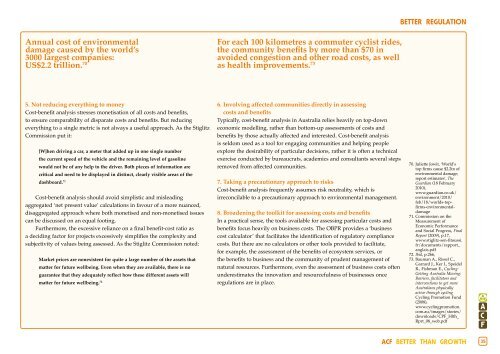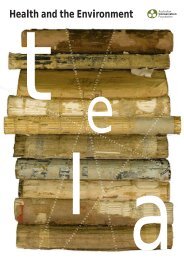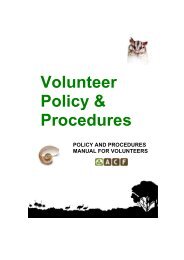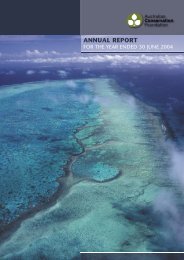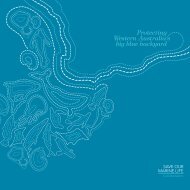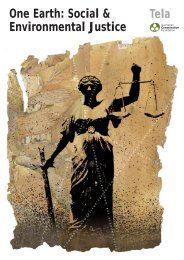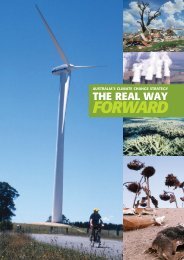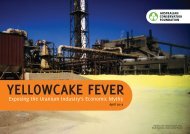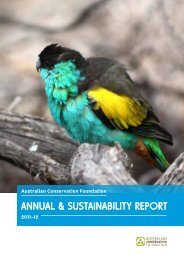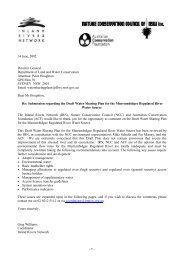Better than growth - Australian Conservation Foundation
Better than growth - Australian Conservation Foundation
Better than growth - Australian Conservation Foundation
You also want an ePaper? Increase the reach of your titles
YUMPU automatically turns print PDFs into web optimized ePapers that Google loves.
etter regulation<br />
Annual cost of environmental<br />
damage caused by the world’s<br />
3000 largest companies:<br />
US$2.2 trillion. 70<br />
For each 100 kilometres a commuter cyclist rides,<br />
the community benefits by more <strong>than</strong> $70 in<br />
avoided congestion and other road costs, as well<br />
as health improvements. 73<br />
5. Not reducing everything to money<br />
Cost-benefit analysis stresses monetisation of all costs and benefits,<br />
to ensure comparability of disparate costs and benefits. But reducing<br />
everything to a single metric is not always a useful approach. As the Stiglitz<br />
Commission put it:<br />
[W]hen driving a car, a meter that added up in one single number<br />
the current speed of the vehicle and the remaining level of gasoline<br />
would not be of any help to the driver. Both pieces of information are<br />
critical and need to be displayed in distinct, clearly visible areas of the<br />
dashboard. 71<br />
Cost-benefit analysis should avoid simplistic and misleading<br />
aggregated ‘net present value’ calculations in favour of a more nuanced,<br />
disaggregated approach where both monetised and non-monetised issues<br />
can be discussed on an equal footing.<br />
Furthermore, the excessive reliance on a final benefit-cost ratio as<br />
a deciding factor for projects excessively simplifies the complexity and<br />
subjectivity of values being assessed. As the Stiglitz Commission noted:<br />
Market prices are nonexistent for quite a large number of the assets that<br />
matter for future wellbeing. Even when they are available, there is no<br />
guarantee that they adequately reflect how these different assets will<br />
matter for future wellbeing. 72<br />
6. Involving affected communities directly in assessing<br />
costs and benefits<br />
Typically, cost-benefit analysis in Australia relies heavily on top-down<br />
economic modelling, rather <strong>than</strong> bottom-up assessments of costs and<br />
benefits by those actually affected and interested. Cost-benefit analysis<br />
is seldom used as a tool for engaging communities and helping people<br />
explore the desirability of particular decisions, rather it is often a technical<br />
exercise conducted by bureaucrats, academics and consultants several steps<br />
removed from affected communities.<br />
7. Taking a precautionary approach to risks<br />
Cost-benefit analysis frequently assumes risk neutrality, which is<br />
irreconcilable to a precautionary approach to environmental management.<br />
8. Broadening the toolkit for assessing costs and benefits<br />
In a practical sense, the tools available for assessing particular costs and<br />
benefits focus heavily on business costs. The OBPR provides a ‘business<br />
cost calculator’ that facilitates the identification of regulatory compliance<br />
costs. But there are no calculators or other tools provided to facilitate,<br />
for example, the assessment of the benefits of ecosystem services, or<br />
the benefits to business and the community of prudent management of<br />
natural resources. Furthermore, even the assessment of business costs often<br />
underestimates the innovation and resourcefulness of businesses once<br />
regulations are in place.<br />
70. Juliette Jowit, ‘World’s<br />
top firms cause $2.2tn of<br />
environmental damage,<br />
report estimates‘, The<br />
Guardian (18 February<br />
2010),<br />
www.guardian.co.uk/<br />
environment/2010/<br />
feb/18/worlds-topfirms-environmentaldamage<br />
71. Commission on the<br />
Measurement of<br />
Economic Performance<br />
and Social Progress, Final<br />
Report (2009), p.17,<br />
www.stiglitz-sen-fitoussi.<br />
fr/documents/rapport_<br />
anglais.pdf<br />
72. Ibid, p.266,<br />
73. Bauman A., Rissel C.,<br />
Garrard J., Ker I., Speidel<br />
R., Fishman E., Cycling:<br />
Getting Australia Moving:<br />
Barriers, facilitators and<br />
interventions to get more<br />
<strong>Australian</strong>s physically<br />
active through cycling<br />
Cycling Promotion Fund<br />
(2008),<br />
www.cyclingpromotion.<br />
com.au/images/stories/<br />
downloads/CPF_Hlth_<br />
Rprt_08_web.pdf<br />
ACF BETTER THAN GROWTH 35


